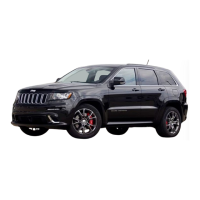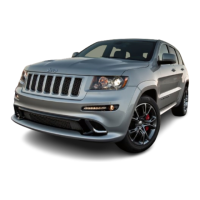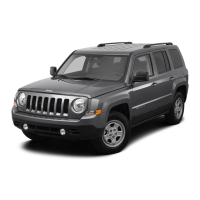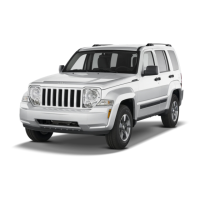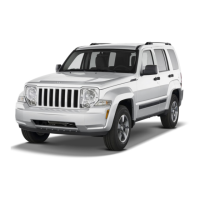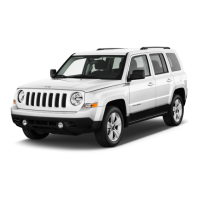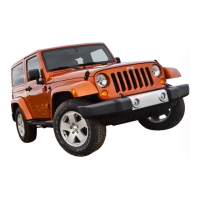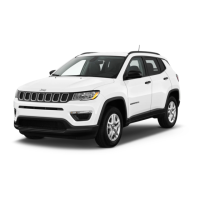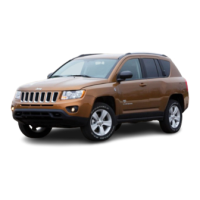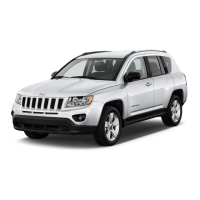
Do you have a question about the Jeep 2012 Compass and is the answer not in the manual?
| Brand | Jeep |
|---|---|
| Model | 2012 Compass |
| Category | Automobile |
| Language | English |
Consult the Table of Contents for information, review descriptions and illustrations.
Utility vehicles have a higher rollover rate; avoid sharp turns and abrupt maneuvers.
Manual contains warnings against unsafe procedures and cautions against vehicle damage.
VIN is found on the left front corner of the instrument panel, visible through the windshield.
Modifications could affect roadworthiness and safety, potentially leading to accidents.
Authorized dealer has key code numbers for locks; use for ordering duplicate keys.
Steps to remove the key from the ignition switch lock cylinder.
Instructions on how to lock and unlock doors using the key.
A signal sounds if the driver's door is open with the key in the ignition.
Immobilizer system prevents unauthorized operation by disabling the engine.
Only programmed keys can be used; programmed keys cannot be used in other vehicles.
Procedure to program new Sentry Keys if you have two valid Sentry Keys.
Monitors doors, liftgate, and ignition switch for unauthorized operation.
System allows locking/unlocking doors and liftgate, or activating Panic Alarm remotely.
Activates headlights for up to 90 seconds when doors are unlocked with RKE transmitter.
Feature causes turn signal lights to flash when doors are locked or unlocked with RKE transmitter.
Press and hold the PANIC button on the RKE transmitter to turn the Panic Alarm feature ON or OFF.
Refer to Sentry Key “Customer Key Programming.”
Instructions for replacing the RKE transmitter battery.
Starts the engine conveniently from outside the vehicle while maintaining security.
Lists all conditions that must be met before the engine will remote start.
Information on manual and power door locks, including auto lock features.
Use the manual door lock knob to lock doors from inside the vehicle.
Use the power door lock switch on the driver's and passenger's door panel.
Door locks automatically when vehicle speed exceeds 15 mph (24 km/h).
Doors unlock automatically if feature is enabled and vehicle conditions are met.
Provides a safer environment for small children riding in rear seats.
Window controls on the driver's door trim panel control all door windows.
Controls for all door windows are on the driver's door trim panel.
Driver's door window switch has an Auto-Down feature.
Allows disabling window control on other doors from the driver's door.
Instructions on how to unlock and open the liftgate using the key or RKE transmitter.
Details on vehicle restraint systems: belts, airbags, and head restraints.
Restraint system for driver and all passengers.
Supplement the seat belt restraint systems for driver and front passenger.
Passive, deployable components that minimize head restraint gap during rear impact.
Protect front and rear seat occupants during side impact and vehicle rollover.
All seating positions are equipped with lap/shoulder belts.
Recommendations for pregnant women on seat belt usage.
Vehicle has Advanced Front Air Bags as a supplement to seat belt restraint systems.
Information on proper restraint systems for babies and children.
Recommends rearward-facing until age two or until height/weight limits are reached.
Guidance on forward-facing child seats and booster seats for children over two.
Explains using Automatic Locking Retractors (ALR) for child restraint systems.
System provides child restraint installation without using vehicle seat belts.
Pets should be restrained in the rear seat in pet harnesses or carriers secured by seat belts.
Drive moderately during the first 300 miles (500 km) for engine and drivetrain break-in.
General safety tips including warnings about children, cargo area, and seat belts.
Warning about carbon monoxide and safety tips to avoid breathing it.
Check seat belts, air bag warning light, and other interior safety items.
Inspect belt system periodically for cuts, frays, loose parts; replace if damaged.
Monitors air bag system electrical components; check if light functions improperly.
Check defroster operation; see dealer if inoperable.
Use only floor mats that leave pedal area unobstructed and are firmly secured.
Checks for tires, lights, door latches, and fluid leaks.
Examine tires for wear, damage, and proper inflation pressure.
Due to limited clearance, tire chains are not recommended.
Use snow tires only in sets of four; check speed ratings.
Rotate tires timely to increase tread life and maintain traction.
Warns of low tire pressure and system malfunctions.
TPMS warning indicator in cluster, uses wireless sensors to monitor tire pressure.
TPMS uses wireless technology with wheel rim mounted electronic sensors.
Telltale light and chime activate for low tire pressure.
Indicates TPMS malfunction or sensor issues.
Recommends unleaded gasoline with 87 octane rating.
Cleaner burning gasoline blended to reduce emissions and improve air quality.
Information on using fuels with oxygenates like Ethanol.
Explains issues and fixes for fueling non-FFV vehicles with E-85.
Discourages gasoline blended with MMT due to potential engine damage.
Detergent additives are not needed under normal conditions.
Guidelines to maintain vehicle performance, avoid leaded gasoline.
Warning about deadly carbon monoxide in exhaust gases and precautions.
Instructions for adding fuel, fuel filler cap, and tether cable.
Location of gas cap, replacement information, and proper tightening.
Message displayed if fuel filler cap is loose or improperly installed.
Vehicle certification label and requirements for loading.
Label contains manufacturer, VIN, date, weight ratings, and vehicle type.
Total allowable weight of vehicle including driver, passengers, and cargo.
Actual tire size on vehicle; replacement tires must match.
Rim size appropriate for the tire size listed.
Cold tire inflation pressure for vehicle, for all loading conditions.
Total weight of vehicle with fluids, at full capacity, no occupants or cargo.
Load carrying components provide satisfactory service if GVWR is not exceeded.
Safety tips and information on trailer towing limits.
Definitions of trailer towing related terms.
Weight of trailer plus cargo, consumables, and equipment in loaded condition.
Total permissible weight of vehicle and trailer when weighed in combination.
Maximum capacity of front and rear axles; distribute load evenly.
Downward force on hitch ball by trailer; consider as part of vehicle load.
Maximum height multiplied by maximum width of the front of a trailer.
Telescoping link to dampen unwanted trailer swaying motions.
Supports trailer tongue weight like luggage at hitch ball or connecting point.
Distributes trailer tongue weight to vehicle's axles for level ride and stability.
Industry standard for maximum trailer weight a hitch class can tow.
Chart provides maximum trailer weight ratings towable for your given drivetrain.
Load trailer with 60-65% weight in front; 10-15% GTW on tow hitch.
Guidelines for proper break-in of vehicle drivetrain components during towing.
Do not interconnect hydraulic/vacuum systems; use controller for electronic brakes.
Dealer offers trailer wiring harness; use factory approved harness and connector.
Diagram and pinout for a four-pin connector.
Diagram and pinout for a seven-pin connector.
Practice turning, stopping, backing trailer; use speed control cautiously.
All starts must be in first gear to avoid excessive clutch slippage.
Change fluid/filter if regularly towing trailer for over 45 minutes.
Do not use in hilly terrain or with heavy loads; disengage if speed drops significantly.
Reduce potential for engine and transmission overheating.
Chart detailing towing conditions, wheels off ground, and transmission requirements.
None for wheels off ground, Not Allowed for Automatic Transmission, NEUTRAL for Manual.
Front NOT ALLOWED/OK, Rear NOT ALLOWED/NOT ALLOWED.
ALL OK for both transmissions.
Manual transmission vehicles can be flat towed at any legal speed if in NEUTRAL.
Do not flat tow automatic transmission vehicles; damage to drivetrain will result.
Covers hazard flashers, engine/transmission overheating, and tire changing.
Emergency warning system; use when vehicle is disabled and creates a hazard.
Steps to reduce overheating potential: slow down, turn off A/C, use heater.
Transmission overheat indicator light may come on during sustained high-speed driving.
Safety warnings and procedures for changing a tire.
Do not change tire near traffic; do not put body under jacked-up vehicle.
Never start engine on jack; use jack only for tire changes on firm level surface.
Jack and jack-handle are stowed under the load floor in the cargo area.
Compact spare tire is stowed under the rear load floor in the cargo area.
Park on firm level surface, turn on hazard flashers, set parking brake, shift to PARK/REVERSE.
Step-by-step instructions for safely jacking the vehicle.
Instructions for installing road tires, with or without wheel covers.
Steps to install road tire on steel wheels with wheel covers.
Instructions for installing road tire on wheels without covers.
Procedures for safely jump-starting a discharged battery using cables or booster pack.
Locate battery in engine compartment, remove air intake duct.
Step-by-step connection of jumper cables to batteries and engine ground.
Use rocking motion by shifting between gears with minimal pedal pressure.
Racing engine or spinning wheels may cause transmission overheating/failure.
Turn Traction Control or ESC OFF before attempting to 'rock' the vehicle.
Procedure to temporarily move shift lever from PARK if malfunction occurs.
Chart detailing towing conditions and allowed methods for automatic/manual transmissions.
Towing instructions for FWD and 4WD vehicles with ignition key.
Do not flat tow disabled vehicle if condition relates to clutch/transmission/driveline.
Using accessories while towed requires key in ON/RUN, transmission in NEUTRAL.
Special care needed when towing with ignition off; use flatbed truck and proper equipment.
Do not use sling-type equipment; do not attach to suspension components.
Covers engine compartment, diagnostics, emissions, parts, dealer service, and maintenance procedures.
Diagram and labels for engine compartment components.
Diagram and labels for engine compartment components.
Monitors emissions, engine, and transmission systems; MIL illuminates if service is needed.
Message appears if fuel filler cap is loose; tighten cap and press reset button.
Requirement to pass emissions inspection; check MIL and OBD II system readiness.
Recommends genuine MOPAR parts for performance and warranty coverage.
Authorized dealers have qualified personnel, tools, and information for expert service.
Details required maintenance services and components requiring future servicing.
Failure to maintain or perform repairs may lead to costly repairs and performance issues.
Instructions for checking oil level, selecting oil, and changing oil/filter.
Check oil level after engine warms up on level ground; maintain between range markings.
Oil change indicator system reminds when service is due; follow schedule.
Recommends API Certified SAE 5W-20 engine oil meeting Chrysler standards.
Replace oil filter with a new, high-quality filter at every engine oil change.
Refer to Maintenance Schedule for proper replacement intervals.
Battery requires no water; periodic maintenance not required.
Battery fluid is corrosive; battery gas is flammable/explosive; handle with care.
Check and service A/C at start of warm season; clean condenser fins, test performance.
Do not use chemical flushes in A/C system; may damage components.
Use only approved refrigerants/lubricants; system contains high-pressure refrigerant.
Lubricate locks, body pivots, hinges periodically with lithium-based grease.
Clean blades and windshield periodically; avoid dry operation or removing ice.
Fill reservoir with windshield washer solvent only; wipe blades clean.
Washer solvents are flammable; exercise care when filling or working around.
Properly maintained system protects against carbon monoxide entry; inspect for damage.
Exhaust gases are deadly; never run engine in closed area or parked vehicle.
Leaded gasoline destroys catalytic converter; keep vehicle in proper operating condition.
Check coolant level and protection; drain/flush/refill if dirty or rusty.
Never open hot cooling system pressure cap; hot coolant/steam can cause burns.
Check coolant protection monthly; flush/refill if dirty.
Refer to Maintenance Schedule for proper intervals.
Use HOAT engine coolant; do not mix types or use propylene glycol.
Mixing coolants can damage engine/decrease protection; do not use water or alcohol.
Use HOAT coolant up to five years/104,000 miles; use same coolant throughout life.
Notes on vapor, leaks, coolant level, freeze point, and hose condition.
Inspect all brake system components periodically; refer to Maintenance Schedule.
Riding brakes can lead to failure/collision; high temperatures/wear can cause damage.
Check fluid level when performing under hood services or if brake warning light is on.
Use only recommended brake fluid; wrong type can damage system/impair performance.
Avoid brake fluid contamination; keep master cylinder cap secure.
Improper brake fluids affect clutch system; damage seals, cause loss of clutch function.
Use proper MOPAR CVTF+4 fluid; do not add additives.
Do not use chemical flushes in transmission; may damage components.
Check fluid level by removing fill plug; maintain between fill hole bottom and 3/16 in below.
Use manufacturer's recommended fluid; refer to Fluids section.
Use manufacturer's recommended MOPAR Gear & Axle Lubricant.
Use manufacturer's recommended MOPAR Gear & Axle Lubricant.
Vehicle body care varies by location; chemicals can affect paint, trim, underbody.
Corrosion is paint/coating deterioration from salt, dirt, moisture, stone impact, etc.
Wash vehicle regularly in shade with mild soap; rinse thoroughly.
Do not use abrasive cleaners, scouring pads, or power washers exceeding 1,200 psi.
Hose undercarriage monthly; keep drain holes clear; touch up paint chips promptly.
Clean aluminum/chrome wheels regularly with mild soap and water.
Do not use scouring pads, steel wool, harsh brushes, or oven cleaner on wheels.
Instructions for cleaning Stain Repel seats using blotting and mild solutions.
Use MOPAR Total Clean for fabric/vinyl; clean leather upholstery with damp cloth.
Do not use volatile solvents; they are flammable and may cause respiratory harm.
Clean plastic headlights with mild soap solution; avoid dry cloths or abrasives.
Clean glass regularly with MOPAR Glass Cleaner; avoid abrasive cleaners.
Low glare surface minimizes windshield reflections; use soap and water to clean.
CAUTION: Read instructions carefully when installing air fresheners.
Clean lenses with wet, soft rag and mild soap; avoid alcohol or abrasives.
Do not use chemical solvents or abrasive cleaners; clean with mild soap/water.
Information on the Integrated Power Module, cartridge and mini-fuses.
Located in engine compartment; contains cartridge fuses and mini-fuses.
Ensure IPM cover is positioned properly; use correct amperage fuse when replacing.
Steps to preserve battery if vehicle is not used for over 21 days.
List of interior bulb numbers; brass/glass wedge base bulbs recommended.
Provides bulb numbers for Front Header, Center Dome, and Rear Cargo Lamp/Flashlight.
Provides bulb numbers for various exterior lights.
Instructions for replacing headlamps and fog lamps.
Steps to remove connector and bulb; handle halogen bulbs carefully.
Access lamp through lower fascia cutout; remove connector and bulb.
Instructions to remove taillamp housing, socket, and bulb.
Remove lamp from liftgate using screwdriver, rotate socket, pull bulb.
LED assembly; see authorized dealer for replacement.
Table showing U.S. and Metric capacities for fuel, engine oil, and cooling system.
Capacity for 2.0L and 2.4L engines.
Capacity for 2.0L and 2.4L engines with HOAT coolant.
Lists recommended fluids, lubricants, and parts for engine and chassis.
Details on engine coolant, oil, filter, spark plugs, and fuel selection.
Details on transmission, drive assembly, PTU, brake master cylinder, and power steering fluids.
Provides scheduled maintenance services to protect vehicle performance and reliability.
Scheduled maintenance services listed in manual must be done at specified times/mileages.
Refer to Maintenance Schedules for required service intervals.
Change engine oil/filter; rotate tires at first sign of irregular wear.
Change oil/filter, rotate tires, inspect air cleaner/AC filter, brake linings, CV joints, exhaust.
Change oil/filter, rotate tires, inspect CV joints, inspect exhaust system.
Change oil/filter, rotate tires, replace air cleaner/spark plugs/AC filter, inspect brakes/suspension.
Change engine oil/filter; rotate tires; inspect air cleaner filter if dusty/off-road.
Change oil/filter, rotate tires, inspect air cleaner/AC filter/brakes/CV joints/exhaust/suspension.
Change engine oil/filter; rotate tires; inspect CV joints, inspect exhaust system.
Change oil/filter, rotate tires, replace air cleaner/AC filter/spark plugs, inspect brakes/suspension.
Change engine oil/filter; rotate tires; inspect CV joints, inspect exhaust system.
Change oil/filter, rotate tires, inspect air cleaner/AC filter/brakes/suspension.
Change engine oil/filter; rotate tires at first sign of irregular wear.
Change oil/filter, rotate tires, replace air cleaner/spark plugs/PCV valve/AC filter, inspect brakes/CV joints/exhaust/suspension.
Change engine oil/filter; rotate tires; flush/replace engine coolant.
Change oil/filter, rotate tires, inspect air cleaner/AC filter/brakes/suspension.
Change engine oil/filter; rotate tires; inspect CV joints, inspect exhaust system.
Change oil/filter, rotate tires, replace air cleaner/spark plugs/AC filter, inspect brakes/suspension.
Change engine oil/filter; rotate tires; inspect CV joints, inspect exhaust system.
Change oil/filter, rotate tires, inspect air cleaner/AC filter/brakes/CV joints/exhaust/suspension.
Change engine oil/filter; rotate tires at first sign of irregular wear.
Service work requires knowledge/equipment; seek competent mechanic if unsure.
Guidance on obtaining service, contacting customer centers, and reporting safety defects.
Prepare for appointment: have papers, discuss charges, keep maintenance log.
Make a written list of vehicle problems or desired work.
Discuss priorities with service advisor; arrange for rental vehicle if needed.
Manufacturer and dealers are interested in your satisfaction; recommend authorized dealer.
Authorized dealers have facilities, technicians, tools, and information for correct service.
Contact information for customer assistance in the U.S.
Contact information for customer assistance in Canada.
Contact information for customer assistance in Mexico.
Provides TDD/TTY communication options for hearing/speech impaired customers.
Information on service contracts for protection against unexpected repair costs.
See Warranty Information Booklet on DVD for terms and provisions.
Genuine MOPAR fluids, lubricants, parts, and accessories recommended for optimal performance.
Inform NHTSA and manufacturer immediately if a defect could cause crash, injury, or death.
Instructions for reporting safety defects to NHTSA.
Contact Transport Canada for reporting safety defects.
Order manuals via website or phone; street address required.
Tire grading categories: Treadwear, Traction, and Temperature.
Comparative rating based on tire wear under controlled government test conditions.
Grades AA, A, B, C represent tire's ability to stop on wet pavement.
Traction grade based on straight-ahead braking only; excludes acceleration, cornering, hydroplaning.
Grades A, B, C represent tire's resistance to heat generation and dissipation.
Temperature grade established for properly inflated, non-overloaded tire.
Overview of instrument panel features and their locations.
Diagram of the instrument cluster with numbered components.
Detailed descriptions of instrument cluster indicators and gauges.
Shows fuel level and indicates fuel door location.
Indicates status of electrical charging system; see dealer if light remains on.
Informs of ETC system problems; see dealer for service if light stays on or flashes.
Indicates low engine oil pressure; stop vehicle and shut off engine if light turns on.
Illuminates when fuel level reaches approximately 2.0 gal (7.8 L).
Shows vehicle speed in miles per hour and/or kilometers per hour.
Monitors air bag system; see dealer if light does not come on, stays on, or flickers.
Arrow flashes with exterior turn signal; continuous chime sounds if signal stays on.
Shows that high beam headlights are on; push lever forward for high beam.
Monitors ABS; indicates malfunction if light remains on while driving.
Illuminates and chimes if driver's seat belt remains unbuckled.
Shows permissible engine revolutions-per-minute for each gear range.
Warns of overheated engine condition; pull over and stop vehicle if light turns on.
Indicates security alarm arming status.
Shows engine coolant temperature; normal range indicates satisfactory cooling system operation.
Indicates that the Electronic Speed Control System is ON.
Indicates the vehicle is in the 4-Wheel Drive mode.
Displays the gear position of the automatic transmission.
Changes display from odometer to trip settings; resets trip odometer.
Illuminates for low tire pressure or system malfunction.
Displays messages for conditions like Door Ajar, Fuel Cap Fault, Low Tire Pressure.
Reminds when to take vehicle for scheduled maintenance.
Allows selection of system status, warnings, compass, trip computer, and phone displays.
Displays compass headings, outside temperature, and current radio station.
Shows average fuel economy since the last reset.
Estimated distance that can be traveled with remaining fuel.
Refer to Starting and Operating for TPMS system operation.
Shows total elapsed time of travel since the last reset.
Allows driver to set and recall features when vehicle is stopped.
When ON selected, all voice commands are confirmed.
Self-calibrating compass; EVIC displays 'CAL' until calibrated.
Procedure to manually calibrate compass if it appears erratic.
Difference between Magnetic North and Geographic North for compensation.
Operating instructions for the media center.
Instructions for operating the radio, including power, volume, and seek.
Push knob to turn radio on/off; rotary knob controls volume.
Volume control turns continuously; adjusts volume to last played level.
Search for next listenable station in AM/FM mode by pressing seek buttons.
Refer to Voice Command section in Understanding The Features Of Your Vehicle.
Press button to operate Uconnect™ Phone; refer to Uconnect™ Phone section.
Operating instructions for the radio.
Instructions for operating the radio.
Precautions for keeping CD/DVDs in good condition.
Conditions affecting radio performance when mobile phone is on.
System designed to maintain comfort in all weather conditions.
Manual temperature controls consist of rotary dials and push knobs.
System automatically maintains cabin climate at desired comfort levels.
Simple operation: turn mode/blower to AUTO, set temperature.
Regulates air amount; seven speeds in manual mode, AUTO position for automatic operation.
Offers manual override features for blower, mode, or both.
Choose from several air distribution patterns or blends.
Air directed through instrument panel outlets.
Air directed through panel and floor outlets; improves comfort in cool conditions.
Air directed through floor outlets with small amount through defrost/demist outlets.
Air through floor, defrost, side window demist outlets; best for cold/snowy conditions.
Air directed through windshield/side window demist outlets for best defrosting.
Puts system in recirculation mode for smoke, odors, dust, or humidity.
Recirculation may cause window fogging in cold weather; disabled in floor/defrost modes.
Press button to engage A/C during manual operation; light illuminates when engaged.
Press A/C button to turn OFF indicator light/compressor for economy.
Adjust seat, mirrors, fasten seat belts before starting vehicle.
Do not leave children unattended; never exit vehicle with engine running.
Apply parking brake, press clutch, place shift lever in NEUTRAL.
WARNING: Apply parking brake fully when unattended.
Upshift as listed in table for optimal fuel economy.
Proper downshifting improves fuel economy and prolongs engine/transmission life.
Skipping gears or downshifting at high speed can damage engine, transmission, or clutch.
Shift lever must be in PARK or NEUTRAL before starting engine.
Damage to transmission may occur if shift precautions are not observed.
Requires shift lever in PARK before turning ignition to LOCK/OFF.
Holds shift lever in PARK unless brakes are applied.
DO NOT race engine when shifting; use each gear in numerical order.
Supplements parking brake; engine can be started in this range; never use while in motion.
Do not race engine when shifting PARK or NEUTRAL; can damage drivetrain.
For moving vehicle backward; shift only after vehicle has come to complete stop.
Use when vehicle is standing for prolonged periods with engine running.
Do not coast in NEUTRAL or turn off ignition to coast downhill; limits response.
Towing, coasting, or driving in NEUTRAL can result in severe transmission damage.
Used for most city/highway driving; provides best fuel economy and characteristics.
Used for engine braking when descending steep grades; downshifts for braking.
Driver-interactive transmission offering six manual ratio changes for more control.
AutoStick activated in DRIVE by moving lever side-to-side.
Deactivated by holding shift lever momentarily or shifting out of DRIVE.
Provides full time, on-demand, four-wheel drive (4WD).
Utility vehicles have higher ground clearance; avoid sharp turns or abrupt maneuvers.
Provides good response and maneuverability; mechanical steering if power assist lost.
Check fluid level if leak suspected, noises apparent, or system not functioning.
Prolonged steering system operation at end of travel increases fluid temperature.
Reduced power steering assist poses safety risk; service immediately.
Ensure parking brake is fully applied when leaving vehicle.
Inspect all brake system components periodically; refer to Maintenance Schedule.
Riding brakes can lead to failure/collision; high temperatures/wear can cause damage.
Driving with brake light on is dangerous; braking performance may decrease.
Provides vehicle stability and performance under braking; prevents wheel lock-up.
Pumping ABS brakes diminishes effectiveness; press pedal firmly, do not pump.
Includes ABS, TCS, BAS, ERM, HDC, HSA, ESC for enhanced stability and control.
Monitors wheel spin; applies brake pressure and reduces engine power.
Optimizes braking capability during emergency maneuvers by applying optimum pressure.
BAS cannot prevent collisions or increase traction; do not exploit capabilities recklessly.
Anticipates potential wheel lift by monitoring steering input and vehicle speed.
Factors like load, road, driving conditions affect wheel lift/rollover chance.
Maintains vehicle speed descending hills during off-road driving.
Assists driver starting vehicle on hill by maintaining brake pressure.
Situations on minor hills may prevent activation; always remember driver is responsible for braking.
Enhances directional control and stability; corrects over/under-steering.
ESC cannot prevent collisions or increase traction; do not exploit capabilities recklessly.
Three modes for 4WD, two for 2WD vehicles.
Normal operating mode for ESC; used for most driving situations.
Disables TCS portion of ESC for conditions requiring more wheel spin.
In Partial Off mode, engine power reduction and stability features are disabled.
Intended for off-highway/off-road use when ESC stability features inhibit maneuverability.
Lights indicate ESC system status or malfunction.
Information on tire markings, identification number, terminology, and loading/pressure.
Diagram and explanation of tire markings.
Location and explanation of the TIN found on tire sidewall.
Definitions for terms like B-Pillar, Cold Tire Inflation Pressure, Maximum Inflation Pressure.
Location of Tire and Loading Information Placard.
Proper tire inflation is essential for safe operation.
Overloading tires is dangerous; can cause failure, affect handling, increase stopping distance.
Improper inflation causes uneven wear, reduces tread life, increases rolling resistance.
Proper inflation contributes to comfortable ride; over-inflation causes jarring ride.
Proper cold pressure listed on B-Pillar or door edge; check monthly.
Maintain correct pressure; increased pressure/reduced load may be required for high speeds.
High speed driving with maximum load is dangerous; tires can fail.
Combine radial tires in sets of four; never mix with other types.
May have original equipment spare or non-matching temporary spare.
Do not use compact spare in automatic car wash; may result in damage.
For temporary emergency use only; has limited tread life.
Compact spares are for emergency use only; do not drive over 50 mph.
For temporary emergency use only; may have limited tread life.
For temporary emergency use only; affects vehicle handling.
Do not use unapproved tires/wheels; may change handling, cause loss of control.
Could result in tire overloading and failure, loss of control.
Replacing tires with different sizes may result in false speedometer readings.
Not recommended due to limited clearance.
Damage to vehicle may result if tire chains are used.
Rotate tires timely to increase tread life and maintain traction.
Warns of low tire pressure based on recommended cold placard pressure.
TPMS warning indicator in cluster, uses wireless sensors to monitor tire pressure.
TPMS uses wireless technology with wheel rim mounted electronic sensors.
Telltale light and chime activate for low tire pressure.
Indicates TPMS malfunction or sensor issues.
Device complies with FCC rules and Industry Canada RSS 210.
Recommends unleaded gasoline with 87 octane rating.
Cleaner burning gasoline blended to reduce emissions and improve air quality.
Information on using fuels with oxygenates like Ethanol.
Explains issues and fixes for fueling non-FFV vehicles with E-85.
Discourages gasoline blended with MMT due to potential engine damage.
Detergent additives are not needed under normal conditions.
Guidelines to maintain vehicle performance, avoid leaded gasoline.
Do not use gasoline with Methanol or >10% Ethanol; may cause driveability problems.
Warning about deadly carbon monoxide in exhaust gases and precautions.
Out-of-tune engine or fuel/ignition malfunctions can cause catalytic converter overheat.
Intentional tampering with emissions control systems can result in civil penalties.
Instructions for adding fuel, fuel filler cap, and tether cable.
Location of gas cap, replacement information, and proper tightening.
Message displayed if fuel filler cap is loose; tighten cap and press reset button.
Vehicle certification label and requirements for loading.
Label contains manufacturer, VIN, date, weight ratings, and vehicle type.
Total allowable weight of vehicle including driver, passengers, and cargo.
Actual tire size on vehicle; replacement tires must match.
Rim size appropriate for the tire size listed.
Cold tire inflation pressure for vehicle, for all loading conditions.
Total weight of vehicle with fluids, at full capacity, no occupants or cargo.
Load carrying components provide satisfactory service if GVWR is not exceeded.
Safety tips and information on trailer towing limits.
Definitions of trailer towing related terms.
Weight of trailer plus cargo, consumables, and equipment in loaded condition.
Total permissible weight of vehicle and trailer when weighed in combination.
Maximum capacity of front and rear axles; distribute load evenly.
Downward force on hitch ball by trailer; consider as part of vehicle load.
Maximum height multiplied by maximum width of the front of a trailer.
Telescoping link to dampen unwanted trailer swaying motions.
Supports trailer tongue weight like luggage at hitch ball or connecting point.
Distributes trailer tongue weight to vehicle's axles for level ride and stability.
Industry standard for maximum trailer weight a hitch class can tow.
Chart provides maximum trailer weight ratings towable for your given drivetrain.
Load trailer with 60-65% weight in front; 10-15% GTW on tow hitch.
Guidelines for proper break-in of vehicle drivetrain components during towing.
Do not interconnect hydraulic/vacuum systems; use controller for electronic brakes.
Dealer offers trailer wiring harness; use factory approved harness and connector.
Diagram and pinout for a four-pin connector.
Diagram and pinout for a seven-pin connector.
Practice turning, stopping, backing trailer; use speed control cautiously.
All starts must be in first gear to avoid excessive clutch slippage.
Change fluid/filter if regularly towing trailer for over 45 minutes.
Do not use in hilly terrain or with heavy loads; disengage if speed drops significantly.
Reduce potential for engine and transmission overheating.
Chart detailing towing conditions, wheels off ground, and transmission requirements.
None for wheels off ground, Not Allowed for Automatic Transmission, NEUTRAL for Manual.
Front NOT ALLOWED/OK, Rear NOT ALLOWED/NOT ALLOWED.
ALL OK for both transmissions.
Manual transmission vehicles can be flat towed at any legal speed if in NEUTRAL.
Do not flat tow automatic transmission vehicles; damage to drivetrain will result.
Emergency warning system; use when vehicle is disabled and creates a hazard.
Steps to reduce overheating potential: slow down, turn off A/C, use heater.
Transmission overheat indicator light may come on during sustained high-speed driving.
Safety warnings and procedures for changing a tire.
Do not change tire near traffic; do not put body under jacked-up vehicle.
Never start engine on jack; use jack only for tire changes on firm level surface.
Jack and jack-handle are stowed under the load floor in the cargo area.
Compact spare tire is stowed under the rear load floor in the cargo area.
Park on firm level surface, turn on hazard flashers, set parking brake, shift to PARK/REVERSE.
Step-by-step instructions for safely jacking the vehicle.
Instructions for installing road tires, with or without wheel covers.
Steps to install road tire on steel wheels with wheel covers.
Instructions for installing road tire on wheels without covers.
Procedures for safely jump-starting a discharged battery using cables or booster pack.
Locate battery in engine compartment, remove air intake duct.
Step-by-step connection of jumper cables to batteries and engine ground.
Use rocking motion by shifting between gears with minimal pedal pressure.
Racing engine or spinning wheels may cause transmission overheating/failure.
Turn Traction Control or ESC OFF before attempting to 'rock' the vehicle.
Procedure to temporarily move shift lever from PARK if malfunction occurs.
Chart detailing towing conditions and allowed methods for automatic/manual transmissions.
Towing instructions for FWD and 4WD vehicles with ignition key.
Do not flat tow disabled vehicle if condition relates to clutch/transmission/driveline.
Using accessories while towed requires key in ON/RUN, transmission in NEUTRAL.
Special care needed when towing with ignition off; use flatbed truck and proper equipment.
Do not use sling-type equipment; do not attach to suspension components.

